Welcome to one of the most active flamenco sites on the Internet. Guests can read most posts but if you want to participate click here to register.
This site is dedicated to the memory of Paco de Lucía, Ron Mitchell, Guy Williams, Linda Elvira, Philip John Lee, Craig Eros, Ben Woods, David Serva and Tom Blackshear who went ahead of us.
We receive 12,200 visitors a month from 200 countries and 1.7 million page impressions a year. To advertise on this site please contact us.
|

|
|
Terms - modal vs tonal, color vs out note
|
You are logged in as Guest
|
|
Users viewing this topic: none
|
|
Login  | |
|

   
joevidetto
Posts: 191
Joined: Jun. 15 2013

|
 Terms - modal vs tonal, color vs ou... Terms - modal vs tonal, color vs ou...
|
|
|
In a recent post, Ricardo mentioned that he feels the simplest way to communicate about flamenco for westerners is to consider flamenco a mix of tonic and modal passages, but not both at the same time. Also, that with a jazz approach, any scale or mode can be used over any chord. I suppose the word 'substitute' can be used in both modal and tonal approaches also.
How many here also use that way of thinking. If you do, where do the terms 'color' and 'out' notes apply in your thinking ? Do you impose those ideas on top of both tonal and modal playing ? If you're clear on this, please give some examples of each case.
I'll give one example - when you play an augmented scale over the b2 chord in flamenco - you're using the 'jazz - any scale over any chord' approach.
--> por medio - A Flamenco - A Bb C# D E F G A
b2 aug scale - Bb C D E F# G# Bb
As I write this down, it occurs to me I'm not sure in the wheel recently shared if A Flamenco is indeed A phrygian - A Bb C D E F G A - I have been viewing A flamenco as A Bb C# D E F G A, but I think the Flamenco 'tonality' is best described by chords from the combination of A phrygian dominant and A phrygian together.
Over a minor triad, if you use a natural minor scale AND in another instance over the same chord use a dorian mode - you may still be in a tonal passage but using the natural 6th as a 'color' or out note.
As always - thanks for sharing and discussing.
|
|
|
|
REPORT THIS POST AS INAPPROPRIATE |
Date Jan. 30 2021 16:37:02
 |
|

   
kitarist
Posts: 1715
Joined: Dec. 4 2012

|
 RE: Terms - modal vs tonal, color v... (in reply to joevidetto) RE: Terms - modal vs tonal, color v... (in reply to joevidetto)
|
|
|
quote:
As I write this down, it occurs to me I'm not sure in the wheel recently shared if A Flamenco is indeed A phrygian - A Bb C D E F G A
The wheel is extended for flamenco on the same principle as how the major and minor keys are interpreted for the regular circle of fifths - the stacked keys are all relative to each other - meaning that they share the same key signature. Since I also added the applicable key signature, all the information is there. A flamenco has only one flat - Bb. Both G and G# are still used, but you have to write the sharp inline. (Just like there are a bunch of note alterations that can happen in minor keys).
Compared to the keys on the middle circle, the inner circle's keys are 1.5 tones (minor third) down, and the flamenco keys are 2 tones(major third) up. Hence the placement when you look at a wheel segment at 12 o'clock, with flamenco being on the outside above the major key and the minor key on the inside below the major key.
If we talk about letters on the wheel as keys, the minor keys are based on scales corresponding to the respective Aeolian mode; the major keys are based on scales corresponding to the respective Ionian mode, and the flamenco keys are based on scales corresponding to the respective Phrygian mode.
However, unlike modes whose scales show all the notes that can be used, the implied scale corresponding to a given tonality/key is not a complete set of allowed notes.
_____________________________
Konstantin
|
|
|
|
REPORT THIS POST AS INAPPROPRIATE |
Date Jan. 30 2021 18:03:12
 |
|

  
ernandez R
Posts: 739
Joined: Mar. 25 2019
From: Alaska USA

|
 RE: Terms - modal vs tonal, color v... (in reply to kitarist) RE: Terms - modal vs tonal, color v... (in reply to kitarist)
|
|
|
quote:
ORIGINAL: kitarist
quote:
As I write this down, it occurs to me I'm not sure in the wheel recently shared if A Flamenco is indeed A phrygian - A Bb C D E F G A
The wheel is extended for flamenco on the same principle as how the major and minor keys are interpreted for the regular circle of fifths - the stacked keys are all relative to each other - meaning that they share the same key signature. Since I also added the applicable key signature, all the information is there. A flamenco has only one flat - Bb. Both G and G# are still used, but you have to write the sharp inline. (Just like there are a bunch of note alterations that can happen in minor keys).
Compared to the keys on the middle circle, the inner circle's keys are 1.5 tones (minor third) down, and the flamenco keys are 2 tones(major third) up. Hence the placement when you look at a wheel segment at 12 o'clock, with flamenco being on the outside above the major key and the minor key on the inside below the major key.
If we talk about letters on the wheel as keys, the minor keys are based on scales corresponding to the respective Aeolian mode; the major keys are based on scales corresponding to the respective Ionian mode, and the flamenco keys are based on scales corresponding to the respective Phrygian mode.
However, unlike modes whose scales show all the notes that can be used, the implied scale corresponding to a given tonality/key is not a complete set of allowed notes.
K, this is good!
Thinking an edited version of this should be on your Flamenco wheel, you know, for us musically challanged ;)
HR
_____________________________
I prefer my flamenco guitar spicy,
doesn't have to be fast,
should have some meat on the bones,
can be raw or well done,
as long as it doesn't sound like it's turning green on an elevator floor.
www.instagram.com/threeriversguitars
|
|
|
|
REPORT THIS POST AS INAPPROPRIATE |
Date Jan. 30 2021 19:01:33
 |
|

   
Brendan
Posts: 353
Joined: Oct. 30 2010

|
 RE: Terms - modal vs tonal, color v... (in reply to joevidetto) RE: Terms - modal vs tonal, color v... (in reply to joevidetto)
|
|
|
My thoughts don’t amount to much, but since you ask: I don’t think about playing scales over chords at all. That’s not really how flamenco works. In fandangos, it makes sense to say that the estribillos are modal while the sung verses are tonal, as long as you don’t think of ‘modal’ as an invitation to start wondering how you would solo over those changes.
Look at this little falseta por bulerías by Paco Cepero. You won’t understand what is going on by asking ‘Which scale was he noodling in over those chords?’ or ‘What mode is this?’. The chords written there are Claude Worms’ attempt to infer harmony from melody, they’re not played. The melody isn’t played ‘over’ them. You can think of the Gb and the Eb as ‘out’ notes if you like, though that does raise the unhelpful question ‘out of what?’ I have no idea what Cepero was thinking in creating this falseta, but I understand it in terms of a harmonic journey. I don’t buy Worms’ first chord—that first stack looks like D major to me! And so the chord implied by the whole first measure is D7(b9). If you think of the second measure as Gm7, a familiar pattern emerges that explains the sense of movement. Cepero parachutes us in to a harmonic location some way from the home chord and the charm of it is how he manages the journey home.
So the Gb (or if I’m right, F#) isn’t an ‘out’ note made palatable by clever jazzy harmonisation, nor is it ‘colour’. It’s part of a functional secondary dominant that invites movement to Gm7.
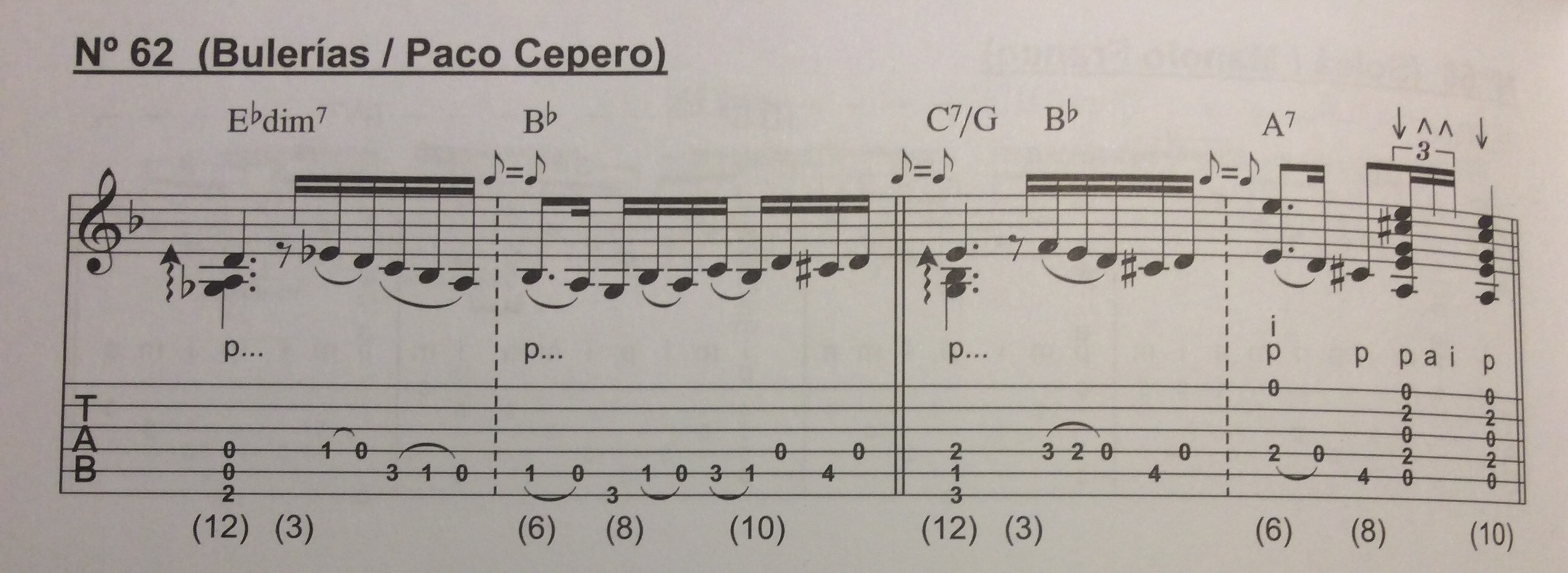
Images are resized automatically to a maximum width of 800px
 Attachment (1) Attachment (1)
_____________________________
https://sites.google.com/site/obscureflamencology/
|
|
|
|
REPORT THIS POST AS INAPPROPRIATE |
Date Jan. 30 2021 20:46:36
 |
|

  
Beni2
Posts: 139
Joined: Apr. 23 2018

|
 RE: Terms - modal vs tonal, color v... (in reply to Brendan) RE: Terms - modal vs tonal, color v... (in reply to Brendan)
|
|
|
quote:
So the Gb (or if I’m right, F#) isn’t an ‘out’ note made palatable by clever jazzy harmonisation, nor is it ‘colour’. It’s part of a functional secondary dominant that invites movement to Gm7. It is not a diatonic note so it is adding color. Play the f natural and you have a diatonic iv chord going to diatonic v or dm/F-e half dim/G.
quote:
Compared to the keys on the middle circle, the inner circle's keys are 1.5 tones (minor third) down, and the flamenco keys are 2 tones(major third) up. Hence the placement when you look at a wheel segment at 12 o'clock, with flamenco being on the outside above the major key and the minor key on the inside below the major key.
I'm sure you know this Konstantin, but for those that don't: an easy mnemonic device is to think of the root, third, and fifth of any minor chord as your relative keys.
Am is spelled a-c-e, so
A = minor
C = Major
E = phrygian
or d minor, d-f-a
D = minor key
F= Major
A = phrygian
I call these key families (extending the "relative" metaphor)
|
|
|
|
REPORT THIS POST AS INAPPROPRIATE |
Date Jan. 30 2021 22:08:00
 |
|

   
Ricardo
Posts: 14801
Joined: Dec. 14 2004
From: Washington DC

|
 RE: Terms - modal vs tonal, color v... (in reply to kitarist) RE: Terms - modal vs tonal, color v... (in reply to kitarist)
|
|
|
quote:
ORIGINAL: kitarist
quote:
K, this is good!
Thinking an edited version of this should be on your Flamenco wheel, you know, for us musically challanged
Thanks HR! However, Ricardo has been posting about this for years here  I'd think for a how-to, he can summarize the basics best, or at least look over what I wrote and add to/edit it. I'd think for a how-to, he can summarize the basics best, or at least look over what I wrote and add to/edit it.
Some relevant information. Most non-flamenco theorists view the normal major/minor circle to encompass all that is needed or possible in equal temperament. They would probably view our augmentation to the circle odd, and after understanding its implications for general music, they would find it redundant. So this augmentation applies specifically and uniquely to flamenco music or flamenco related fusions (I am thinking jazz fusion guys, guitar trio etc). So let me first speak on the inner portion of the circle first.
The most relevant thing the circle reveals to guitar players is the relative “family of chords” that share a key signature. What that means is this. If you take the turning wheel and pick a key or key center you are interested in (by note name), lets say B major. What you do is turn the wheel so B/G#minor are in the 12 o’clock postion. What you can now visualize is the family of chords encompassed by the 11 o’clock, 12 o’clock and 1 o’clock positions only. Again, only talking about the inner two rings. You can see there are 3 majors and 3 minors in the family. Left to right that is E-B-F# and underneath C#m- G#m-D#m. Ignoring the scale or other relationships to those chords at first you can notice that if you have a song that uses any combination of those 6 chords, in any sequence, well, they all share the key signature seen at 12 o’clock. So that means 5# in their specific order. So something as simple as E->D#m chords back and forth, even without claiming them from the “Key of B or G#minor” you become aware they share a single scale of notes with 5#. The concept of E lydian, or D# phrygian is arbitrary as you are simply using the same notes for both harmonies.
From there you can notice if you have sequence that uses B-G#m-E-C#m, that you have a situation that can be EITHER 5# OR 4# because no information is given by the chords themselves to tell you which position the wheel is sitting in. That means you can force a “Meaning” or “flavor” upon the progression simply by using a melody that either has A# or A natural, your choice. Over time of experimenting, both your ear and your mind will develop a command over how chords scales and keys operate all together. You start to develop an intuition about the “sameness” of mixolydian sound (F# major using the 5#, or in other words the 1 o’clock position chord) and dominant function. Anytime you invoke a mixolydian sounding melody, your are creating a dominant type function relative to whatever you were doing before that. For example playing B mixolydian is the same as turn the wheel one click to the right such that now E or 4# are sitting at 12 o’clock. In fact ANY accidental against your existing key signature is creating a new tritone situation. For example a G natural suddenly appears in your melody and you suddenly have to turn your wheel until a G natural pops up (2# position) and you realize that you might be evoking a B minor type sound (most often the F#7b9 is what is invoked, but there are other options such as E minor, again borrowed from the 2# family).
The way “secondary dominant function” works is you are briefly turning your wheel to tonicize any specific chord in your key. So If I want to tonicize C# minor, I locate C# major first (Db on this wheel) look at the 1 o’clock postion chord (Ab major) and thusly precede my C#minor with some form of an Ab dominant7 chord or melody. The more consonant sound will be the one that relates to our 5# situation (G#7b9 for example, phrygian dominant sound vs Ab mixolydian).
That specific example brings in the “problem” with Minor key V-i functions in general. The actual v chord in C#minor is a G# minor chord, and it has a very weak pull such that it is indistinguishable from and E major key passage moving politely from iii-vi....so minor keys necessarily BORROW the strong 1 o’clock dominant chord function in order to tonicize the minor key tonic. That borrowing, as you can see on the wheel here, is why accidentals in the minor key are introduced. Harmonic minor created by borrowing the 1 o’clock postion chords from the same named major key. Melodic minor borrows the 11 o’clock chord as well. (Db postion again has Gb chord on left, and the Ab discussed on the right. That means C# melodic minor can use an F# major chord AND the G# major chord thanks to the borrowing of those two chords).
Once the tricky solutions to minor keys are learned and understood, we can then starting looking at Flamenco “keys” and how they function. Simply put, the tritone sub for the 1 o’clock postion chord in dominant7 form is what is used. Going back to our 5# situation, we see D# as the “flamenco key”. The 1 o’clock postion chord is Bb/A#...the tritone sub of which is E natural. So an E7 chord serves to pull strongly to D# phrygian key. We can see E is already in the chord family in the major ring 11 o’clock position. So that same chord position can always be used to force a phrygian cadence anytime we want....and indeed when modulations are done (more often in modern flamenco than traditional), that is how it is done. Example, you want to tonicize an F# flamenco sound (Taranta), instead of jump there you can make a smooth transition by using the 11 o’clock position major (G major) and making it dominant (G7) serves to strengthen the move.
I could go on but that is already a lot for now.
_____________________________
CD's and transcriptions available here:
www.ricardomarlow.com
|
|
|
|
REPORT THIS POST AS INAPPROPRIATE |
Date Jan. 31 2021 20:54:48
 |
|

   
kitarist
Posts: 1715
Joined: Dec. 4 2012

|
 RE: Terms - modal vs tonal, color v... (in reply to Ricardo) RE: Terms - modal vs tonal, color v... (in reply to Ricardo)
|
|
|
I'd like to add some basic, but interesting, properties of the flamenco circle of fifths (most are unique to it except #2 which is also true for the regular minor-major version).
#1: The flamenco key is a 5th up from its relative minor key; hence this expanded circle of fifths has even more fifths than the usual one (this is also why the "minor triad" trick works).
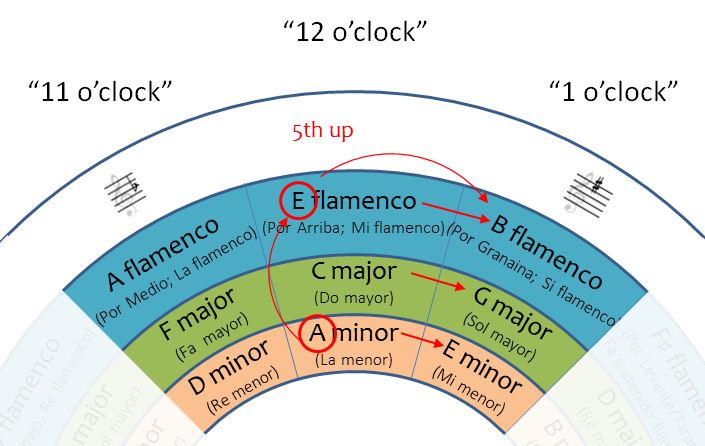
#2: Every other o’clock (on each circle) is a whole tone up/down from one another (same as with the usual circle):
All even o’clocks (12, 2, 4, 6, 8, 10) are a whole tone from each neighbour;
All odd o’clocks (1, 3, 5, 7, 9, 11) are a whole tone from each neighbour;
(because two stacked fifths (7 semitones (st) each) equal an octave + 2st)
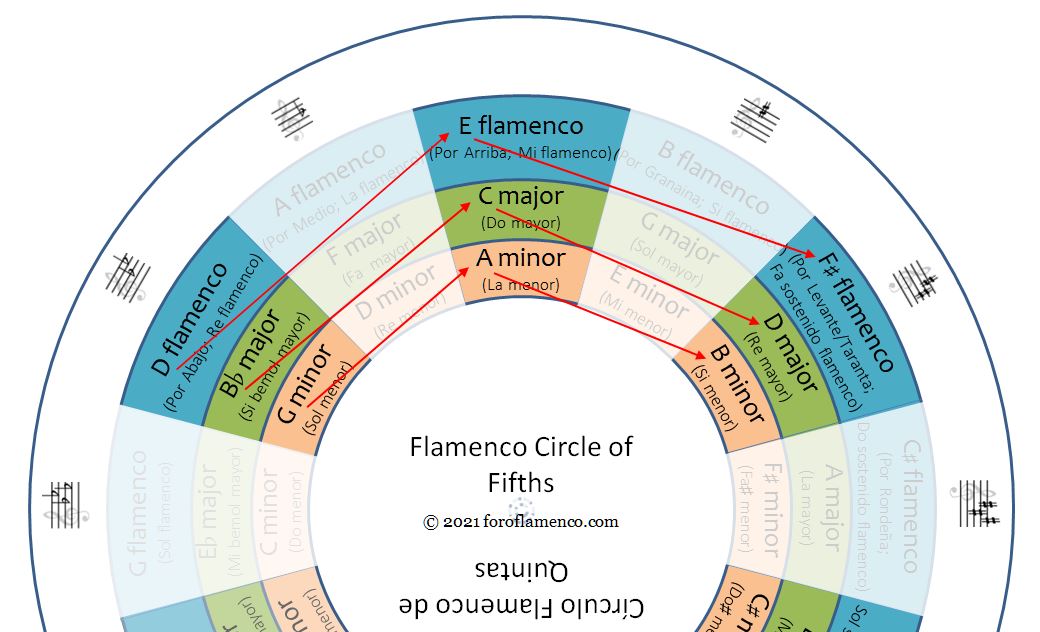
#3: "N" o’clock minor and "N-1" o’clock flamenco are always parallel keys (because both are a fifth down from "N" o’clock flamenco; example below with "N"="12")
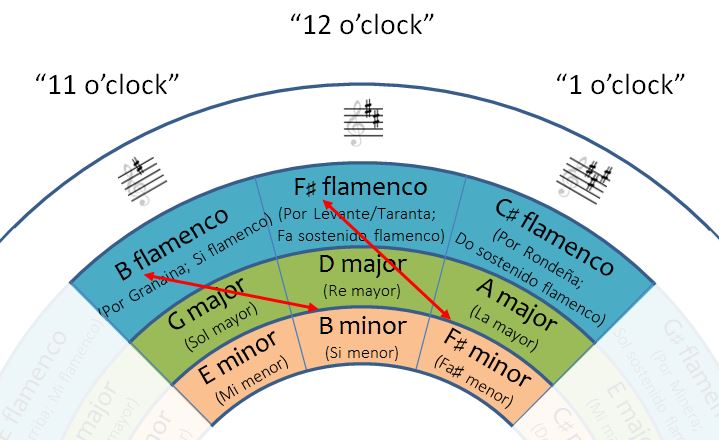
#4: Within the three families at 11, 12, and 1 o’clock, there are always 7 unique tonic notes forming the diatonic scale with the key signature of the 12 o’clock family - including any flats or sharps.
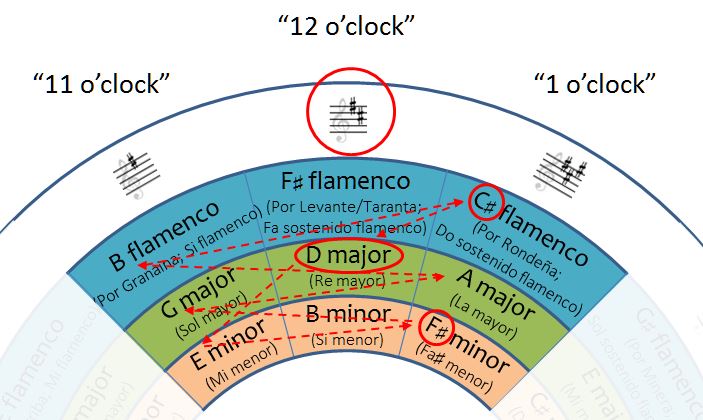
Also 1 o’clock flamenco is a whole tone up from 12 o’clock minor (because two stacked fifths (7st each) equal an octave + 2st), and 1 o’clock major is a whole tone down from 12 o’clock minor (because a 5th (7st) and a minor 3rd (3st) make an octave minus - 2st).
Images are resized automatically to a maximum width of 800px
 Attachment (4) Attachment (4)
_____________________________
Konstantin
|
|
|
|
REPORT THIS POST AS INAPPROPRIATE |
Date Feb. 1 2021 21:07:08
 |
|

   
Ricardo
Posts: 14801
Joined: Dec. 14 2004
From: Washington DC

|
 RE: Terms - modal vs tonal, color v... (in reply to kitarist) RE: Terms - modal vs tonal, color v... (in reply to kitarist)
|
|
|
In an attempt to not over complicate it, it is important to note, in regards to your parallel relations (F# minor key and F# flamenco key are next door neighbors as you point out), that the required dominant function borrowing (a good quarter turn around to F# major is where you borrow the related dominant C# chord) is actually what the “flamenco key ring” is lining up for us. In other words, F# minor key now has the borrowed Dominant directly above it at 12 o’clock, but in the form of “C# flamenco”. Since we don’t have to turn the wheel anymore to show the relation to F# minor, many theorists that are not versed in flamenco forms would see it as nothing more than the minor key at work (the flamenco key ring being redundant info we have drawn in over complicating the simpler picture).
So it is important for the student using this thing to understand that we need to think of the flamenco portion of the wheel as a “special case” situation for flamenco purpose only. You were probably thinking after you made the “parallel key is next door” connection that, oops parallel major is WAY over there...the reason is simple. Aeolian and Phrygian share all notes but ONE...so modal neighbors are already clearly defined by the normal circle by choosing a note name (say your F# position) and positioning it at furthest flat or sharp location and clicking next door either direction. So starting F# flamenco that is phrygian 2#, then you click over one F#m adds one sharp (3#), then click F#m has 4 sharps (Dorian) then the next click F#m disappears but Gb/F# major appears at 1 o’clock with 5#, (dominant or mixolydian), then 6# it is 12 o’clock ionian, then 5b is at 12 o’clock you have Gb Lydian...one more turn and Gb disappears utterly.
One thing I didn’t discuss earlier about our family of 6 chords per key signature. Well there is the 7th chord, we know and love, as m7b5...or the vii diminished chord, locrian mode, half diminished 7 etc. The beauty of that one chord is it contains the tritone or diminished 5th, root to 5...and those two notes tell you what your key signature is all by themselves. So take your F# example again. F#m7b5...F#-C tells you that you only have one sharp. So the locrian mode and your Lydian mode are sort of book ends for the portion of the circle you can deal with that can use that ONE NOTE. Also the m7b5 chord can function as a substitute for the dominant chord of your key because it has so much nice info. Example...F#m7b5 can pull you do E minor, G major, OR B flamenco (as we see in Granaina for example).
In terms of drawing arrows, it would be good to see things like fandango copla arrows (in F# flamenco again, D->G->D->A->D-G->F# flamenco), or the circle of 5th sequence in key (again F#flamenco->Bm-Em-A-D-G-(C#alt ie G7)-F# flamenco) and the andalusian cadence (Bm-A -G-F#flamenco) since those are the types of chord functions we normally deal with.
_____________________________
CD's and transcriptions available here:
www.ricardomarlow.com
|
|
|
|
REPORT THIS POST AS INAPPROPRIATE |
Date Feb. 1 2021 21:48:34
 |
|

   
Ricardo
Posts: 14801
Joined: Dec. 14 2004
From: Washington DC

|
 RE: Terms - modal vs tonal, color v... (in reply to Sr. Martins) RE: Terms - modal vs tonal, color v... (in reply to Sr. Martins)
|
|
|
quote:
ORIGINAL: Sr. Martins
quote:
And this specific VERSION of the circle helps understand the “KEY family” aspect of flamenco vs the isolated mode concept.
Ok, maybe this is what I missed. F and G are the chords for sure but I find it helpful to think of the available extensions as modes. Naturally these are modes from an intervallic perspective only, not tonal.
Exactly...that is the jazz approach where each chord is THOUGHT of as a potential 13th chord of some sort with it’s own “Mode” or scale, ignoring the “progression”. Further, 2-5-1 chord relations are also thought as 3 separate entities rather than a “key” family, at least in advanced jazz concepts. That system is geared to improvisation and chord chart reading/interpretation. Main point is even though all that seems very different on paper, the wheel is still encompassing ALL that info, plus the more classical “tonal” view of keys how chords “should” move or function in a key, etc. And it turns out, in most cases, Flamenco music is functioning less like the “jazz discipline” and more like the baroque tonal discipline.
_____________________________
CD's and transcriptions available here:
www.ricardomarlow.com
|
|
|
|
REPORT THIS POST AS INAPPROPRIATE |
Date Feb. 2 2021 18:38:18
 |
|
 New Messages New Messages |
 No New Messages No New Messages |
 Hot Topic w/ New Messages Hot Topic w/ New Messages |
 Hot Topic w/o New Messages Hot Topic w/o New Messages |
 Locked w/ New Messages Locked w/ New Messages |
 Locked w/o New Messages Locked w/o New Messages |
|
 Post New Thread
Post New Thread
 Reply to Message
Reply to Message
 Post New Poll
Post New Poll
 Submit Vote
Submit Vote
 Delete My Own Post
Delete My Own Post
 Delete My Own Thread
Delete My Own Thread
 Rate Posts
Rate Posts
|
|
|
Forum Software powered by ASP Playground Advanced Edition 2.0.5
Copyright © 2000 - 2003 ASPPlayground.NET |
8.984375E-02 secs.
|


 Printable Version
Printable Version




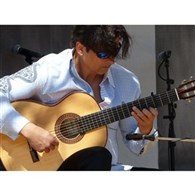

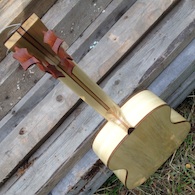




 I'd think for a how-to, he can summarize the basics best, or at least look over what I wrote and add to/edit it.
I'd think for a how-to, he can summarize the basics best, or at least look over what I wrote and add to/edit it. 



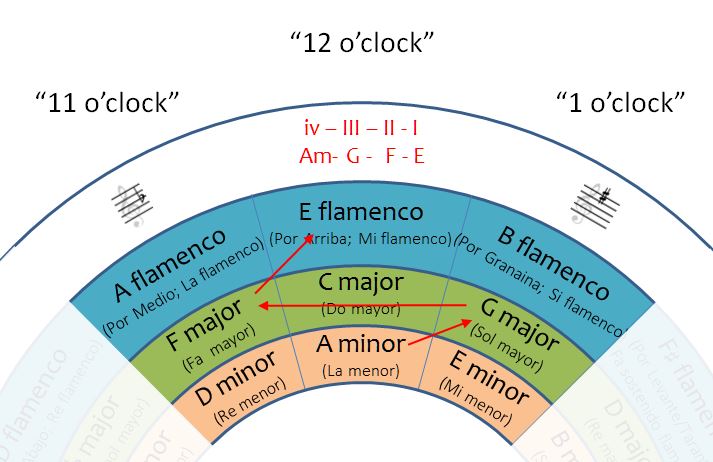
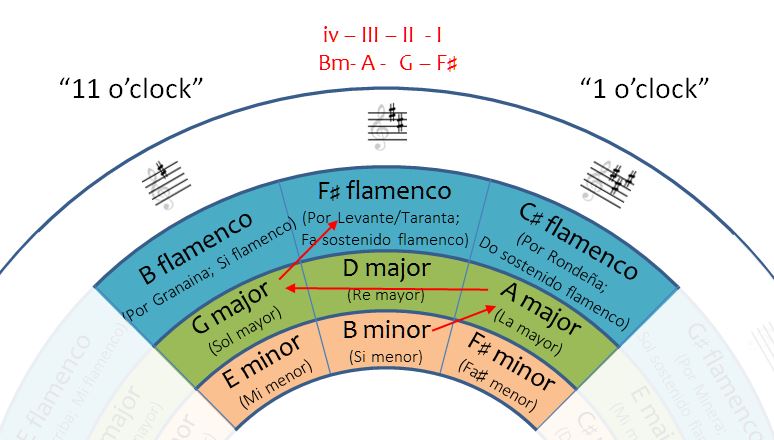

 New Messages
New Messages No New Messages
No New Messages Hot Topic w/ New Messages
Hot Topic w/ New Messages Hot Topic w/o New Messages
Hot Topic w/o New Messages Locked w/ New Messages
Locked w/ New Messages Locked w/o New Messages
Locked w/o New Messages Post New Thread
Post New Thread